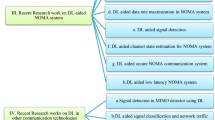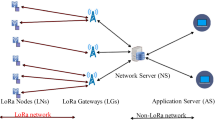Abstract
Deep learning (DL) has been recognized as an instrumental tool for the design of future communication systems. Since it is still not clear whether a fully data-driven end-to-end communication learning approach would eventually outperform the traditional ones in terms of performance and complexity, it is argued that the optimal design needs to be tackled by taking the benefits of both model-based and data-driven approaches and by leveraging the concept of transfer learning. However, the grand question lies in how this can be implemented efficiently. As such, this paper proposes an efficient end-to-end OFDM based receiver learning approach based on distributed data-driven and model-based approaches. The approach relies mainly on augmenting a typical OFDM receiver’s processing blocks with a shallow neural network as a data-driven stub to improve its performance. Relying on a two-phases training approach, the last receiver’s processing stage benefits from the transfer learning approach to improve its performance. Limiting the scope to a typical OFDM transmission where the DL-based methods fail, the proposed model-aided shallow learning receiver shows performance improvements compared to the baseline structure.




Similar content being viewed by others
Notes
So far, recent results from [3, 11, 19] reveal counter intuitive facts for the linear OFDM case where the baseline model is hard to outperform. The linear case is defined as a case where there is no noticeable clipping noise and/or the removal of the cyclic prefix. All wireless systems (e.g. 4G, 5G and IEEE 802.11) operates under such quasi-linear case because the clipping noise is almost minimized using predistortion techniques that shall provide better than 45 dB adjacent channel leakage ratio and low error vector magnitude (EVM). All OFDM waveforms adopted in such technologies are CP based as well.
The partitioning of the dataset to a training set and a test set is a deeply rooted practice using a typical ratio of 20–30% for the test set. We have in fact tried several partitioning ratios within such a range but the results are not worth mentioning as they do not add any insights.
For comparison, it is not trivial to reproduce the results in [21, 18, 19] using our IEEE 802.11 transmission model. In fact, it is time consuming to fine-tune the hyper parameters of such models and one may end up not providing a faire implementation of those techniques. We therefore rely on the baseline models which are proven to be robust and widely used as a reference method.
References
Zappone, A., Di Renzo, M., & Debbah, M. (2019). Wireless networks design in the era of deep learning: model-based, ai-based, or both? IEEE Transactions on Communications, 67(10), 7331–7376.
Björnson, E., Sanguinetti, L., Wymeersch, H., Hoydis, J., & Marzetta, T. L. (2019). Massive MIMO is a reality—What is next? five promising research directions for antenna arrays. Digital Signal Processing, 94, 3–20.
Qin, Z., Ye, H., Li, G. Y., & Juang, B. F. (2019). Deep learning in physical layer communications. IEEE Wireless Communications, 26(2), 93–99.
O’Shea, T., & Hoydis, J. (2017). An introduction to deep learning for the physical layer. IEEE Transactions on Cognitive Communications and Networking, 3(4), 563–575.
Samuel, N., Diskin, T. & Wiesel, A. (2017). Deep MIMO detection. In IEEE international workshop on signal processing advances in wireless communications (SPAWC), Sapporo (pp. 1–5).
O’Shea, T. J., Corgan, J., & Clancy, T. C. (2016). Unsupervised representation learning of structured radio communication signals. In IEEE international workshop sensing, processing and learning for intelligent machines (SPLINE) (pp. 1–5).
Gruber, T., Cammerer, S., Hoydis, J. & ten Brink, S. (2017). On deep learning based channel decoding. In: IEEE annual conference on information sciences and systems (CISS), Baltimore, MD (pp. 1–6).
Jiang, C., Zhang, H., Ren, Y., Han, Z., Chen, K.-C., & Hanzo, L. (2017). Machine learning paradigms for next-generation wireless networks. IEEE Wireless Communications, 24(2), 98–105.
Felix, A., Cammerer, S., Dörner, S., Hoydis, J. & ten Brink, S. (2018). OFDM-Autoencoder for end-to-end learning of communications systems. In IEEE international workshop on signal processing advances in wireless communications (SPAWC), Kalamata (pp. 1–5).
Dörner, S., et al. (2018). Deep learning based communication over the air. IEEE Journal Selected Topics Signal Processing, 12(1), 132–143.
Ye, H., Ye Li, G., & Fred Juang, B.-H. (2018). Power of deep learning for channel estimation and signal detection in OFDM systems. IEEE Wireless Communications Letters, 7(1), 114–117.
Samuel, N., Diskin, T., & Wiesel, A. (2019). Learning to detect. IEEE Transactions on Signal Processing, 67(10), 2554–2564.
Xue, S., et al. (2019). Unsupervised deep learning for MU-SIMO joint transmitter and noncoherent receiver design. IEEE Wireless Communications Letters, 8(1), 177–180.
Ahmed Ouameur, M. & Massicotte, D. (2020). Deep autoencoder for interconnect’s bandwidth relaxation in large scale MIMO-OFDM processing (submitted). In European Signal processing conference (EURASIP), Amsterdam, Netherlands (pp. 1–5).
Nachmani, E., Beery, Y., & Burshtein, D. (2016). Learning to decode linear codes using deep learning. In IEEE annual allerton conference communication, control, and computing (Allerton) (pp. 341–346).
Ahmed Ouameur, M., & Massicotte, D. (2019). Early results on deep unfolded conjugate gradient based large scale MIMO detection. IET Communications (submitted).
Pan, S. J., & Yang, Q. (2010). A survey on transfer learning. IEEE Transactions on Knowledge and Data Engineering, 22(10), 1345–1359.
Gao, X., Jin, S., Wen, C., & Li, G. Y. (2018). ComNet: Combination of deep learning and expert knowledge in OFDM receivers. IEEE Communications Letters, 22(12), 2627–2630.
O’Shea, T., Karra, K., & Clancy, T. C. (2017). Learning approximate neural estimators for wireless channel state information. In IEEE international workshop on machine learning for signal processing (MLSP), Tokyo (pp. 1–7).
Wu, H., Sun, Z., & Zhou, X. (2018). Deep learning-based frame and timing synchronization for end-to-end communications. In International conference on communication, image and signal processing, Sanya, China.
Speth, M., Classen, F., & Meyr, H. (1997). Frame synchronization of OFDM systems in frequency selective fading channels. In IEEE vehicular technology conference technology, Phoenix, AZ, USA (pp. 1807–1811).
Schmidl, T. M., & Cox, D. C. (1997). Robust frequency and timing synchronization for OFDM. IEEE Transactions on Communications, 45(12), 1613–1621.
Moose, P. H. (1994). A technique for orthogonal frequency division multiplexing frequency offset correction. IEEE Transactions on Communications, 42(10), 2908–2914.
Classen, F., & Meyr, H. (1994). Frequency synchronization algorithms for OFDM systems suitable for communication over frequency selective fading channels. IEEE vehicular technology conference (VTC), Stockholm, Sweden (pp. 1655–1659).
Colieri, S., Ergen, M., Puri, A., & Bahai A. (2002). A study of channel estimation in OFDM systems. In IEEE vehicular technology conference, Vancouver, BC, Canada (pp. 894–898).
Parhi, K. K. (1999). vlsi digital signal processing systems: Design and implementation (1st ed.). New York: Wiley.
Acknowledgements
This work has been funded by the Natural Sciences and Engineering Research Council of Canada, Canadian Foundation for Innovation, and the CMC Microsystems. The authors would also like to thank Philippe Massicotte for his help in the CPU/GPU setups.
Author information
Authors and Affiliations
Corresponding author
Additional information
Publisher's Note
Springer Nature remains neutral with regard to jurisdictional claims in published maps and institutional affiliations.
D. Massicotte holds the Chaire de recherche sur les signaux et l’intelligence des systèmes haute performance.
Rights and permissions
About this article
Cite this article
Ahmed Ouameur, M., Lê, A.D.T. & Massicotte, D. Model-aided distributed shallow learning for OFDM receiver in IEEE 802.11 channel model. Wireless Netw 26, 5427–5436 (2020). https://doi.org/10.1007/s11276-020-02412-1
Published:
Issue Date:
DOI: https://doi.org/10.1007/s11276-020-02412-1




